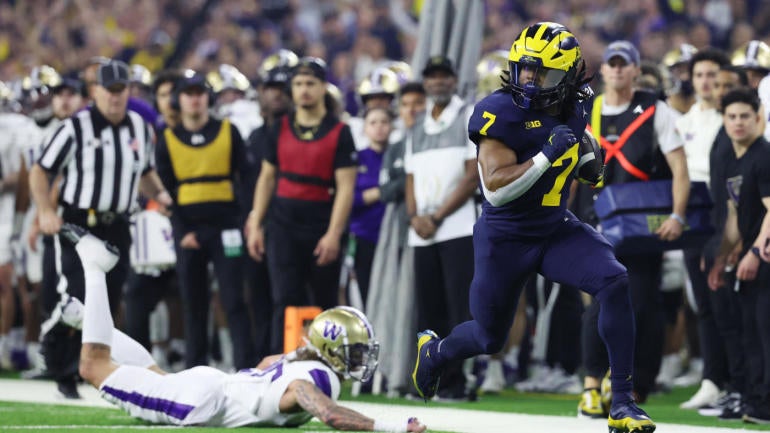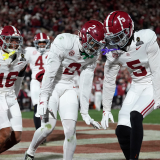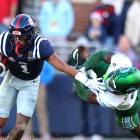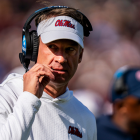In studying champions of College Football Playoff era, the saying 'run the ball to win' is truer than ever
With games getting shorter, running the ball effectively matters more than ever

Congratulations, everyone. We did it. We made it through another offseason. Realignment, NIL, transfer portal, and media days are all in our rearview mirror for the time being. Those things are all important, but they aren't what matters most in college football. Now we get to celebrate the game we love and enjoy the thing that actually does matter the most: the games.
With training camps underway, players are getting acclimated and preparing their minds and bodies for the insanity of a college football season. They have 25 practices to get themselves ready to hit the ground running when their team kicks off in Week 1. They also have time to bond and build relationships with their teammates off the field. Fans get to see a lot of the coverage around practices, and they'll probably see a viral video or two of their favorite team getting a surprise day off to recover and do some team bonding.
What fans don't get to see are the hours upon hours of meetings that take place during fall camp. With most players not having classes to attend in early August, there's more time and focus on football than any other time of the year. There are team meetings, position meetings, and walk-throughs where players are taught and shown what their responsibilities are depending on the down, distance, time, and score. These small details will be the difference between a win and a loss for your team in the fall.
Sitting in these team and position meetings, which I did when I worked at Stanford and Minnesota, is like being in an advanced football history class. When players aren't practicing, lifting weights, or recovering, they're likely in a meeting room getting a master's course in football from their coaches. Stories will be told, examples will be shown, and a lot of longtime football sayings will be shared. One of the most common sayings is used to get across the importance of running the ball in order to win games. Unless your team runs an Air Raid or Run 'n' Shoot offense, you'll most likely hear the saying in your meeting room. That saying is:
"Throw the ball to score and run the ball to win."
I'm sure when all the players got their hands on EA Sports College Football 25, their first thought wasn't about running the ball effectively and stopping the run in order to win. We're in a modern era where quarterbacks and wide receivers get more and more attention, and the running back position gets devalued more and more each year. Just look at the 2024 draft for an example of how these positions are viewed. For the first time ever, six of the first 12 picks were quarterbacks. The six taken tied a first-round record set by the famous QB class of 1983 that included John Elway and Dan Marino. Not to be outdone, seven wide receivers were drafted in the first round, tying the record set in 2004. In fact, 10 wideouts were selected in the first 37 picks, which was the fastest 10 have ever come off the board in draft history.
On the flip side, the draft didn't go nearly as well for running backs. No running backs were selected in the first round for the second time in three years. There have only been four drafts since the 1970 AFL-NFL merger that haven't had an RB taken in the first round, and now it's happened twice in three years. Texas' Jonathon Brooks was the first running back selected in the 2024 draft, and he had to wait to hear his name called until the 14th pick of the second round (46th overall). That was the second-latest pick ever for the first running back to be taken off the board.
The game is so hyper-focused on quarterbacks that a running back, a position that's won 44 Heisman trophies, hasn't won one since Alabama's Derrick Henry did so in 2015. Quarterbacks have won three straight, seven of the last eight, and 12 of the last 14 Heismans.
Does running the ball still matter?
With the way the game has been trending for the last decade, one would think that the answer is no and that passing the ball is more important than running the ball. Our win percentage data goes back to 2016, so let's check the last eight years and see.
We'll look for the answer by examining what the win percentage is for teams that out-rush their opponents. How do the top teams each year do when they out-rush their opponents? Does the win percentage hold true in College Football Playoff games? And where are the numbers trending with recent rule changes and style of play?
Since 2016, FBS teams that outrushed their opponent have won 78% of their games, while Power Five teams have won 80%. Those high win percentage numbers mirror that of turnover margin, which has always been recognized as one of the most important statistics in correlation to winning. Since 2016, FBS teams that won the turnover battle won 78% of the time, and Power Five teams won 80%. So believe it or not, outrushing your opponent has been just as valuable as winning the turnover battle over the last decade.
Rush Yards Winner Win % vs Turnover Winner Win % (since 2016)
| Rush Yards | Turnovers | |
|---|---|---|
| FBS | 78% | 78% |
| Power 5 | 80% | 80% |
Below are year-by-year breakdowns of the winning percentages, and in no year does the win percentage dip below 76% in either FBS or Power Five conferences.
Rush Yards Winner Win % in FBS
| 2016 | 81% |
| 2017 | 76% |
| 2018 | 78% |
| 2019 | 80% |
| 2020 | 76% |
| 2021 | 78% |
| 2022 | 77% |
| 2023 | 79% |
| Average | 78% |
Rush Yards Winner Win % in Power 5
| 2016 | 82% |
| 2017 | 81% |
| 2018 | 79% |
| 2019 | 80% |
| 2020 | 76% |
| 2021 | 78% |
| 2022 | 81% |
| 2023 | 79% |
| Average | 80% |
In 2023, FBS win percentage and Power Five conference teams' winning percentage were an identical 79% for the teams that had more rush yards than their opponents. Compare that to when FBS teams and Power Five teams had more pass yards than opponents, and the numbers dropped to 62% and 66%, respectively. That shows that running the ball more effectively than your opponent still gives you a much higher win probability than passing the ball for more yards than your opponent.
For those interested in knowing how these numbers look in comparison to the pass-happy NFL like I was, their numbers were virtually even in 2023. Teams that had more rush yards than opponents won 68% of the time, and teams leading the pass yards battle won 67% of the time. Over the last decade, winning rush yards has resulted in a 70% win percentage, and winning pass yards equals a 58% win percentage, but the tide may be shifting in the league because the 67% win percentage when winning pass yards in 2023 was the highest this century. The 68% win percentage when winning rush yards was the third lowest win percentage this century.
When looking into how winning the rush yards battle affects games in individual conferences, there was one conference where winning the rush yards battle just meant more. That conference was the SEC. Winning the rushing battle meant more in the SEC in 2023 than winning the turnover battle (83% win rate), in that it led to a 90-14 record and the highest winning percentage of any conference in the nation at 87%. Since 2016, SEC teams have won 82% of the time when winning rush yards and 80% of the time when winning the turnover battle.
2023 Rush Yards Winner Win % (Power Five)
| W-L | Win Pct. | |
|---|---|---|
| SEC | 90-14 | 87% |
| ACC | 78-20 | 80% |
| Big Ten | 77-23 | 77% |
| Big 12 | 77-25 | 76% |
| Pac-12 | 61-19 | 76% |
| Total | 392-102 | 79% |
Power Five Rush Yards Winner Win % (Since 2016)
| W-L | Win Pct. | |
|---|---|---|
| SEC | 663-144 | 82% |
| Big Ten | 603-152 | 80% |
| ACC | 614-165 | 79% |
| Big 12 | 455-128 | 78% |
| Pac-12 | 445-127 | 78% |
| Total | 2,780-716 | 80% |
When studying how the best teams win games, rushing yards proves important as well. Looking at all 40 teams that have made it to the College Football Playoff since it began in 2014 shows that those teams combined to become a virtual lock when winning the rushing battle. CFP teams are 402-15 with a 96% win percentage in games where they outrush their opponent.
CFP Teams Win Rate When Winning Rush Yards
| 2014 | 39-1 |
| 2015 | 40-2 |
| 2016 | 43-2 |
| 2017 | 44-2 |
| 2018 | 38-1 |
| 2019 | 29-2 |
| 2020 | 39-0 |
| 2021 | 43-1 |
| 2022 | 47-1 |
| 2023 | 40-3 |
| Total | 402-15 (96%) |
Looking at the CFP games themselves shows that the rush yards battle is again equal in importance to the turnover battle. In the 30 CFP games that have been played, the team that won rush yards won 80% of the time, and the team that won the turnover battle won 80% of the time, with nearly identical records. The 10 CFP title games are equal as well, in that the team that won rushing went 7-3, and the team that won turnovers also went 7-3.
The 10 national champions of the playoff era dominated in games when winning the rush yards battle. Those ten teams combined to lose three games in ten years when they out-rushed their opponents. They're 113-3 with 97% winning percentage over that span. Seven of the ten CFP champs won 12-plus games when winning the rush yards battle in their title season and only 2016 Clemson (9-0) and 2019 LSU (3-1) won less than double digit games.
Playoff Champ's Season Record When Winning Rush Yards Battle
| 2014 | Ohio State | 12-0 |
| 2015 | Alabama | 11-1 |
| 2016 | Clemson | 9-0 |
| 2017 | Alabama | 12-1 |
| 2018 | Clemson | 12-0 |
| 2019 | LSU | 3-1 |
| 2020 | Alabama | 12-0 |
| 2021 | Georgia | 14-0 |
| 2022 | Georgia | 15-0 |
| 2023 | Michigan | 13-0 |
| Total | 113-3 (97%) |
All of this data isn't to suggest that teams should run the ball just for the sake of it, but it does show that if you're able to run the ball more effectively than your opponent, then you're going to win around 80% of the time. The game has been trending towards a much bigger focus on quarterbacks and passing, but the numbers show that running the ball better than your opponent is just as important as it was a decade ago. That should prove just as important this season again after the clock rules that were changed in 2023.
FBS games are getting shorter, and teams average fewer plays per game than years past. Eight years ago, there was an average of 72 offensive plays per game per team, with an average of 40 rush attempts per game per team. In 2023, with the clock no longer stopping after teams gained a first down outside the final two minutes of each half, those averages dropped to 67 offensive plays per game, with an average of 36 rush attempts. Five plays per game may not sound like a lot, but it is actually a dramatic drop from a decade ago.
FBS Plays Per Game Trends
| 2016 | 2023 | |
|---|---|---|
| Plays Per Game | 72 | 67 |
| Rush Attempts Per Game | 40 | 36 |
Quicker games with fewer plays mean that teams who establish their run game and slow down their opponents' ground game can control the clock and dictate games more than ever before at the collegiate level. If you're going against an elite team that establishes its run game against you and can shorten games with its rush offense, then best of luck to you. Since 2016, Power Five conference champions have won 95% of their games when having 40-plus rush attempts. CFP National Title winning teams have won 97% of their games (67-2) when their offense runs the ball 40-plus times in a game and are 44-0 since 2016.
All of this takes us back to that old saying, "throw the ball to score and run the ball to win." It's as true now as it was back then. The teams that learn that saying in their meetings and then execute it on the field in the fall will put themselves in a good position to win. It doesn't guarantee a win, but it does put you in the driver's seat to control games. As the great Brian Fantana once said in the classic film Anchorman, "60 percent of the time, it works every time." That's one old saying players probably won't learn in their fall camp meetings.

















